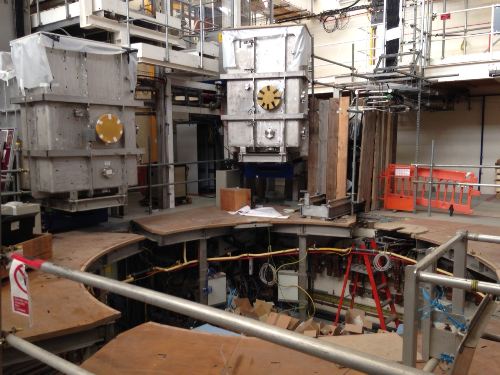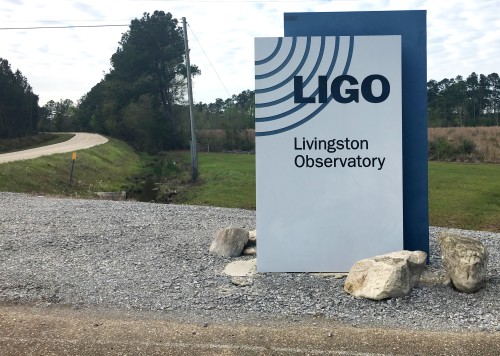Tag archives: facilities
Riding around KAGRA

Tunnel vision: entry point to the KAGRA gravitational-wave observatory in Kamioka. (Courtesy: Michael Banks)
By Michael Banks in Kamioka, Japan
Of all the places I have been, I can’t remember being asked to ride a bicycle for 3 km down a dimly lit tunnel that had water dripping – sometimes pouring – from the ceiling.
But that’s what happened today when I visited the KAGRA gravitational-wave observatory in northern Japan.
Rising bright and early – a common occurrence this week thanks to jet lag – I took the Shinkansen from Tokyo to Toyama.
View all posts by this author | View this author's profile
A temporary lack of neutrons

The guide hall at the HANARO research reactor in Daejeon, Republic of Korea.
By Margaret Harris in Daejeon, Republic of Korea
For almost three years, the HANARO research reactor has been idle. Built in 1995 as a hub for neutron-scattering experiments, radioisotope production and other scientific work, HANARO (High Flux Advanced Neutron Application Reactor) is the only facility of its kind in the Republic of Korea, and it underwent a major upgrade in 2009. Then, in 2014, the facility became a delayed casualty of the meltdown at Japan’s Fukushima Dai-Ichi nuclear power station, as enhanced regulatory scrutiny led to the discovery that the reactor hall’s outer wall was not up to the latest standards. An enforced shutdown followed while the wall was reinforced, and although the works were supposed to take just 18 months, opposition from local citizens’ groups has led to further delays.
View all posts by this author | View this author's profile
Physics World visits LIGO Livingston
By Tushna Commissariat and Sarah Tesh at LIGO Livingston, Louisiana, US
Being a journalist can be a busy and often stressful job, especially as deadlines loom fast and furious. But one of the best perks of the job is the chance to meet some amazing people and visit some of the best scientific facilities in the world. As most regualr readers of Physics World will know, we – Sarah and Tushna – have been in New Orleans, Lousiana for the APS March Meeting 2017. And it just so happens that about a two-hour drive away from New Orleans lies one half of one of the most advanced experiments in the world – the Laser Interferometer Gravitational-wave Observatory (LIGO) at Livingston.
View all posts by this author | View this author's profile
Putting China at the forefront of neutron science

The target station for the China Spallation Neutron Source in Dongguan, China.
By Michael Banks in Dongguan, Guangdong province, China
Today I took the 60 km trip north from Shenzhen to Dongguan – home of the China Spallation Neutron Source (CSNS).
China has two nuclear reactors that generate neutrons for research via nuclear fission, but the CSNS is the country’s first spallation source. This type of facility accelerates protons before smashing them into a target to produce copious amounts of neutrons. They are then sent to numerous instruments that are used by researchers to study materials.
View all posts by this author | View this author's profile
Physics World 2015 Focus on Neutron Science is out now
By Michael Banks
For physicists who love scattering neutrons off materials, the recent ground-breaking ceremony at the European Spallation Source (ESS) in Lund, Sweden, will have been a long time coming. First proposed more than two decades ago, the ESS will – when it finally opens in 2020 – generate the world’s most intense beams of neutrons and help satisfy demand for these most useful of particles.
Neutron scattering has emerged as a mainstream scientific endeavour over the last 20–30 years, which is one reason why this month sees the first-ever Physics World focus issue on neutron science. We take a look at how researchers at the ESS are designing the facility’s tungsten target, as well as a new neutron source being built in China and how the ISIS Neutron and Muon Source in the UK is looking to bring in more users from industry.
View all posts by this author | View this author's profile
Preparing for DEMO

Laying the groundwork: engineers are rebuilding the Mega Amp Spherical Tokamak. (Courtesy: Michael Banks)
By Michael Banks
Yesterday I took the train from Bristol and headed to the Culham Centre for Fusion Energy (CCFE) in Oxfordshire.
Owned and operated by the United Kingdom Atomic Energy Authority, the CCFE is already home to the Joint European Torus (JET) tokamak, which in 2011 underwent a £60m upgrade programme that involved replacing the carbon tiles in the inner reactor wall with beryllium and tungsten. The purpose of this retrofit was to test the materials that are to be used in the ITER fusion experiment, which is currently being built in Cadarache, France.
View all posts by this author | View this author's profile

